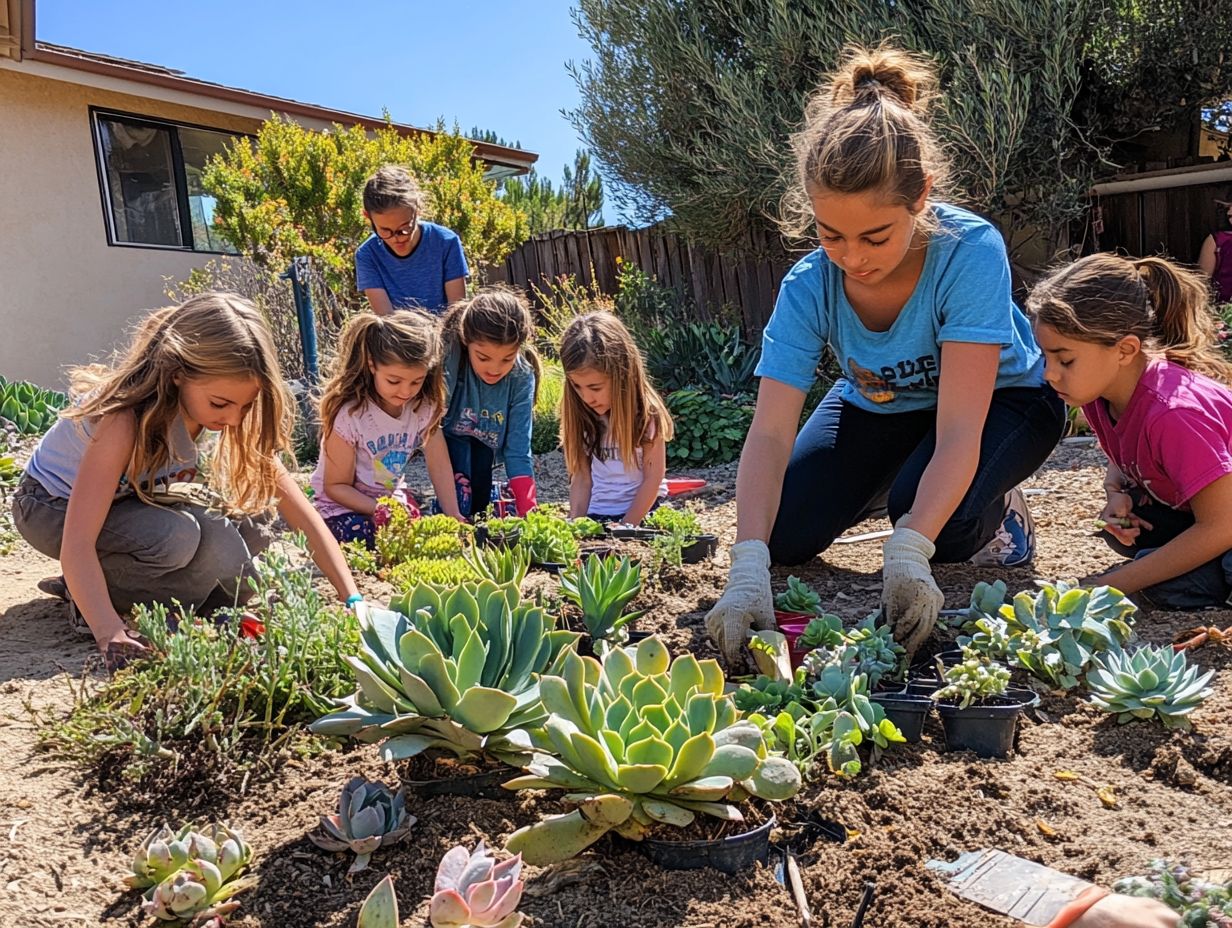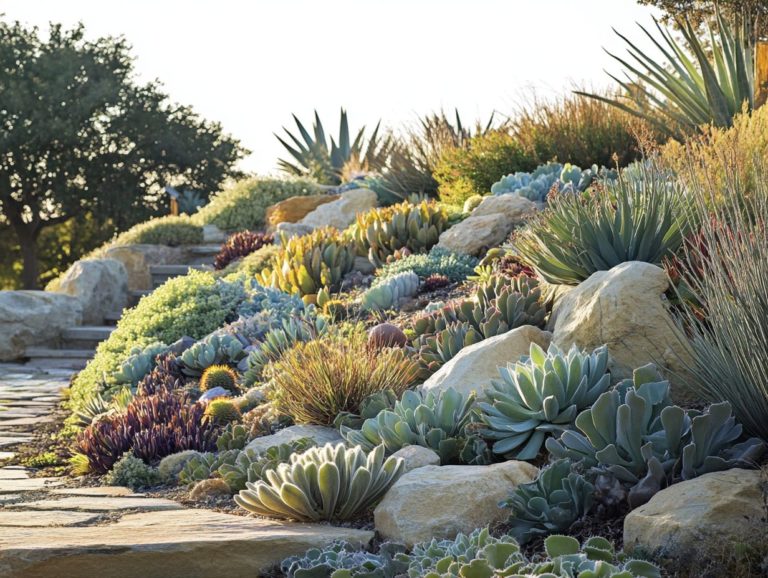How to Educate Kids About Drought Gardening
Drought gardening transcends mere survival for plants; it serves as a powerful educational tool to instill in children a sense of environmental stewardship and the critical importance of water conservation.
This guide delves into the essence of drought gardening and its myriad benefits, especially for young minds.
Discover how to select the ideal plants, develop effective watering strategies, and captivate children with hands-on activities that transform sustainability learning into an engaging adventure.
Embrace the journey of cultivating a greener future, one child at a time.
Contents
- Key Takeaways:
- Understanding Drought Gardening
- Benefits of Teaching Kids About Drought Gardening
- Getting Started with Drought Gardening
- Teaching Kids the Importance of Water Conservation
- Fun Activities for Kids in the Drought Garden
- Frequently Asked Questions
- What is drought gardening?
- How can I get my kids interested in drought gardening?
- What are some fun ways to teach kids about drought gardening?
- Why is it important to educate kids about drought gardening?
- What are some easy drought gardening techniques to teach kids?
- How can I make drought gardening a learning experience for my kids?
Key Takeaways:

- Teach kids about drought gardening to promote environmental awareness and sustainable practices.
- Engage kids in hands-on learning and creative projects in the garden to make drought gardening fun and interactive.
- Emphasize the importance of water conservation to kids by involving them in creating a watering plan and choosing drought-resistant plants.
Understanding Drought Gardening
Understanding drought gardening is crucial in today s evolving climate, especially in areas like California and Oklahoma, where water scarcity is becoming a pressing issue. This approach champions sustainable gardening practices and fosters the growth of plants that thrive despite drought conditions.
By concentrating on nurturing a healthy soil ecosystem, you can ensure your plants remain robust and maximize food production even with restricted water availability.
Drought gardening highlights the importance of selecting the right plant varieties, utilizing compost, and embracing eco-friendly practices to cultivate a thriving garden.
What is Drought Gardening?
Drought gardening is a refined approach tailored for those looking to flourish in conditions with limited water availability, emphasizing the selection of plants that demand minimal irrigation.
This method champions the use of native plants, expertly adapted to your local climate and resilient during extended dry spells. You ll find that deep-rooted species thrive here, reaching deep into the soil to access moisture and enhancing the garden’s overall resilience.
Soil composition is equally vital. By incorporating amendments that boost moisture retention, you ensure your plants have the water they need, even in the driest of times. Adopting effective water conservation techniques, such as mulching which means applying a layer of organic material to retain moisture and drip irrigation, a system that delivers water directly to the roots, nurtures plant health and fosters a sustainable environment. This ultimately contributes to a more resilient ecosystem.
Benefits of Teaching Kids About Drought Gardening
Teaching children about drought gardening offers a wealth of benefits, from fostering a deep sense of environmental awareness to creating enriching educational opportunities that encourage their connection with nature. By learning how to educate others about drought gardening, they can become advocates for sustainable practices.
When you engage kids in hands-on gardening activities, they not only grasp the significance of sustainable gardening practices but also appreciate the vital role of water conservation in nurturing a thriving garden ecosystem. As they dive into tasks like seed starting and plant care, children acquire valuable insights into the lifecycle of plants and the importance of maintaining healthy soil.
Environmental and Educational Benefits

The environmental and educational benefits of drought gardening are truly remarkable. Experience the thrill of conserving water while boosting biodiversity and fostering healthy ecosystems.
By opting for drought-resistant plants, you minimize your ecological footprint and create habitats that support local wildlife, contributing to a more resilient environment. This approach also reduces your reliance on irrigation systems, amplifying your water conservation efforts during dry spells.
When children engage in drought gardening, they gain invaluable insights into various plant species suited for arid conditions and discover the critical importance of sustainable practices. Exploring innovative ideas for drought gardening through these hands-on activities nurtures a deeper understanding of ecology, empowering the next generation to appreciate and safeguard our planet’s resources.
Join us in making a difference today by starting your own drought garden!
Getting Started with Drought Gardening
Embarking on drought gardening requires careful planning and understanding of several crucial factors. You’ll want to select plants that thrive in extended dry spells, taking their unique water requirements into account.
This thoughtful approach ensures a flourishing garden, even in the face of limited moisture.
Choosing the Right Plants
Choosing the right plants is essential in drought gardening. By opting for native and drought-resistant varieties, you can significantly reduce water consumption.
Incorporate a mix of vegetables and herbs that thrive in arid conditions. This approach enhances your garden’s productivity while conserving vital resources.
Embracing native herbs like sage, oregano, and rosemary not only elevates your culinary creations but also attracts beneficial pollinators. Select vegetables such as tomatoes, peppers, and squash that flourish during dry spells for impressive harvests.
When planning your drought-resistant garden, it’s crucial to assess soil quality. Choose plant varieties with deep roots capable of reaching moisture from lower soil layers.
Opting for local species promotes biodiversity and cultivates a resilient ecosystem that adapts seamlessly to changing climate conditions.
Creating a Watering Plan
Creating a watering plan for a drought garden is essential for ensuring your plants receive the hydration they need while promoting water conservation.
By implementing tailored techniques like drip irrigation, you can deliver water directly to the root zone. This effectively minimizes water loss and runoff.
Timing is equally crucial. Watering in the early morning or late afternoon can significantly reduce moisture loss to the sun.
Understanding the specific needs of your plants allows you to determine the ideal watering frequency. This fosters a balanced approach that encourages stronger root development.
These practices enhance plant health and contribute to sustainable garden management, aligning with eco-friendly principles and reducing your reliance on municipal water sources.
Teaching Kids the Importance of Water Conservation

Instilling the importance of water conservation in children is crucial to drought gardening, as it prepares them to understand how to plan your garden for drought seasons and nurtures their growth into environmentally conscious individuals.
Ways to Conserve Water in the Garden
You have several effective strategies at your disposal to conserve water in your garden. Implementing mulch is a fantastic way to retain soil moisture.
Practice weed control to reduce competition for that precious water.
Using organic materials like wood chips or straw as mulch not only helps regulate soil temperature but also enriches your garden over time.
By adopting practices that enhance soil health, such as incorporating compost or vermiculite, you can significantly boost your soil’s ability to retain moisture.
Consider using drip irrigation systems, which deliver water directly to the roots of your plants, minimizing evaporation. Collecting rainwater in barrels can further enhance this efficient watering method, promoting sustainability in your drought gardening efforts.
By employing these strategies, you can successfully navigate the challenges of water scarcity while nurturing a vibrant and thriving ecosystem.
Fun Activities for Kids in the Drought Garden
Engaging children in delightful activities within the drought garden makes gardening a fun adventure. It also imparts essential lessons on sustainability and environmental stewardship.
Getting hands-on captivates their imagination and nurtures a deeper understanding of how to care for our planet.
Ready to start your drought garden? Dive in today and make a difference!
Hands-on Learning and Creative Projects
Hands-on learning and creative projects are vital for understanding drought gardening. They help you connect with nature in a meaningful way.
Activities like creating a garden journal let you observe plant growth and weather patterns firsthand. Building a simple irrigation system teaches water conservation and offers a rewarding sense of accomplishment.
Starting a compost pile provides valuable insights into waste reduction and soil health. These enjoyable projects provide practical knowledge about sustainable practices. They help cultivate a lifelong commitment to caring for the environment.
Frequently Asked Questions

What is drought gardening?
Drought gardening focuses on using water-efficient methods to grow plants during a drought. This includes techniques like using plants that need less water, mulching, and collecting rainwater.
How can I get my kids interested in drought gardening?
Involve kids in the planning process. Let them help choose which plants to grow and teach them about the importance of conserving water. Make it a fun activity by creating a themed garden or having a competition to see who can grow the biggest or most unique plant.
What are some fun ways to teach kids about drought gardening?
There are many interactive ways to teach kids about drought gardening. Create a scavenger hunt to find different water-efficient plants in your neighborhood or participate in hands-on gardening activities. Exploring educational programs focused on drought gardening can also enhance their learning experience, and watching educational videos together can be enjoyable.
Why is it important to educate kids about drought gardening?
Teaching kids about drought gardening is exciting! It shows them how to conserve water and care for the environment. They develop a sense of responsibility and are encouraged to make environmentally-friendly choices in the future.
What are some easy drought gardening techniques to teach kids?
Easy techniques include using mulch to retain soil moisture, planting water-efficient plants like succulents, and using a watering can instead of a hose to save water. Teach them about composting and utilizing rainwater for watering plants.
How can I make drought gardening a learning experience for my kids?
Drought gardening can be a great learning experience. Have kids research different water-efficient plants and their characteristics. They can create a budget for their garden and keep a gardening journal to track progress. For those looking to dive deeper, exploring how to get started with drought-resistant gardening is also an opportunity to teach them about the water cycle and the importance of water conservation.






